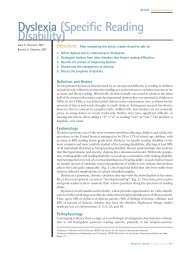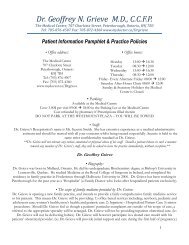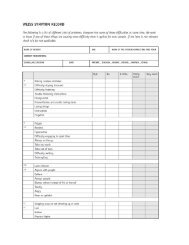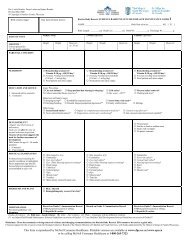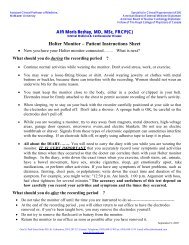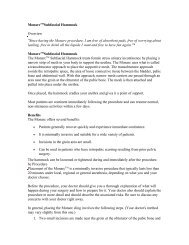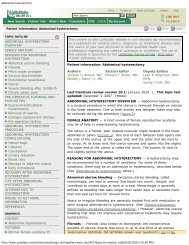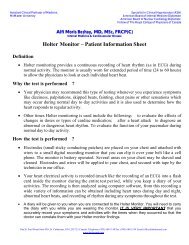BENIGN PAROXYSMAL POSITIONAL VERTIGO - Mydoctor.ca
BENIGN PAROXYSMAL POSITIONAL VERTIGO - Mydoctor.ca
BENIGN PAROXYSMAL POSITIONAL VERTIGO - Mydoctor.ca
You also want an ePaper? Increase the reach of your titles
YUMPU automatically turns print PDFs into web optimized ePapers that Google loves.
BPPV -- <strong>BENIGN</strong> <strong>PAROXYSMAL</strong> <strong>POSITIONAL</strong> <strong>VERTIGO</strong>10/02/2005 01:37 PMBrandt-Daroff exercisesTime Exercise DurationMorningNoonEvening5repetitions5repetitions5repetitions10minutes10minutes10minutesStart sitting upright (position 1). Then move into the side-lying position (position 2), with the head angledupward about halfway. An easy way to remember this is to imagine someone standing about 6 feet in frontof you, and just keep looking at their head at all times. Stay in the side-lying position for 30 seconds, oruntil the dizziness subsides if this is longer, then go back to the sitting position (position 3). Stay there for30 seconds, and then go to the opposite side (position 4) and follow the same routine.These exercises should be performed for two weeks, three times per day, or for three weeks, twice per day.This adds up to 52 sets in total. In most persons, complete relief from symptoms is obtained after 30 sets, orabout 10 days. In approximately 30 percent of patients, BPPV will recur within one year. If BPPV recurs,you may wish to add one 10-minute exercise to your daily routine (Amin et al, 1999). The Brandt-Daroffexercises as well as the Semont and Epley maneuvers are compared in an article by Brandt (1994), listed inthe reference section.When performing the Brandt-Daroff maneuver, <strong>ca</strong>ution is advised should neurologi<strong>ca</strong>l symptoms (i.e.weakness, numbness, visual changes other than vertigo) occur. Oc<strong>ca</strong>sionally such symptoms are <strong>ca</strong>used bycompression of the vertebral arteries (Sakaguchi et al, 2003). In this situation we advise not proceeding withthe exercises and consulting ones physician.Supplemental material on the site CD: Animation of Brandt-Daroff exercises. Note that this treatment maneuver is done faster in the animation than in actual use.Usually one allows 30 seconds between positions.Supplemental material on the site CD: Movie of Brandt-Daroff exercisesHOME EPLEY MANEUVERThe Epley and/or Semont maneuvers as described above <strong>ca</strong>n be done at home (Furman and Hain, 2004).For example, http://www.charite.de/ch/neuro/vertigo.html outlines a self-treatment Epley protocol. We mayrecommend the home-Epley to our patients who have a clear diagnosis. This procedure seems to be evenmore effective than the in-office procedure, perhaps be<strong>ca</strong>use it is repeated every night for a week.There are, however, several possible problems that may arise. If the diagnosis of BPPV has not beenconfirmed, one may be attempting to treat another condition (such as a brain tumor or stroke) withpositional exercises -- this is unlikely to be successful and may delay proper treatment. A second problem isthat the home-Epley requires knowledge of the "bad" side. Sometimes this <strong>ca</strong>n be tricky to establish.Compli<strong>ca</strong>tions such as conversion to another <strong>ca</strong>nal (see below) <strong>ca</strong>n occur during the Epley maneuver, whichare better handled in a doctor's office than at home. Finally, oc<strong>ca</strong>sionally during the Epley maneuverneurologi<strong>ca</strong>l symptoms are provoked due to compression of the vertebral arteries. In our opinion, it is saferhttp://www.dizziness-and-balance.com/disorders/bppv/bppv.htmlPage 7 of 13




